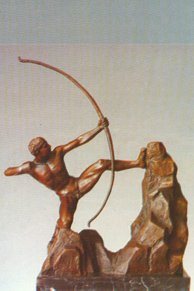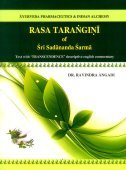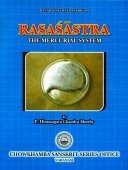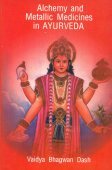Carman, Carma, Cārma, Carmā: 34 definitions
Introduction:
Carman means something in Buddhism, Pali, Hinduism, Sanskrit, Jainism, Prakrit, the history of ancient India, Marathi, Hindi, Tamil. If you want to know the exact meaning, history, etymology or English translation of this term then check out the descriptions on this page. Add your comment or reference to a book if you want to contribute to this summary article.
Alternative spellings of this word include Charman.
In Hinduism
Dhanurveda (science of warfare)
Source: Wisdom Library: DhanurvedaCarma (चर्म) refers to a weapon (“shield”). It is a Sanskrit word defined in the Dhanurveda-saṃhitā, which contains a list of no less than 117 weapons. The Dhanurveda-saṃhitā is said to have been composed by the sage Vasiṣṭha, who in turn transmitted it trough a tradition of sages, which can eventually be traced to Śiva and Brahmā.

Dhanurveda (धनुर्वेद) refers to the “knowledge of warfare” and, as an upaveda, is associated with the Ṛgveda. It contains instructions on warfare, archery and ancient Indian martial arts, dating back to the 2nd-3rd millennium BCE.
Ayurveda (science of life)
Toxicology (Study and Treatment of poison)
Source: Shodhganga: Kasyapa Samhita—Text on Visha ChikitsaCarman (चर्मन्) or “skin” refers to one of the ten sources of plant poison, as described in the Kāśyapa Saṃhitā: an ancient Sanskrit text from the Pāñcarātra tradition dealing with both Tantra and Viṣacikitsā—an important topic from Āyurveda which deals with the study of Toxicology (Viṣavidyā or Sarpavidyā).—Kaśyapa states in the fourth Adhyāya that Śiva taught him that poisons are of five kinds viz. immobile, mobile, artificial, caused by planets and (arising out of) doubt. The sources of plant poison, ten in number are [viz. skin (carman)]. The speed in which they spread too are varied (KS. XII.66):
Unclassified Ayurveda definitions
Source: gurumukhi.ru: Ayurveda glossary of termsCarma (चर्म):—Skin
Source: Research Gate: On Fish in Manasollasa (c. 1131 AD)Carma or Carmaja refers to “scaleless fish”, according to the Mānasollāsa or Abhilaṣitārthachintāmaṇi, an ancient 12th-century Sanskrit text describing thirty-five kinds of marine and fresh water fishes.—In all 35 names have been given by Someshvardeva with minimal information on their habitat (marine or fresh water), presence or absence of scales (carmaja–scaleless; shalkaja–scaly), and size (large, medium, small). Even this information is not given for each fish. As pointed out before the Western Chalukya empire included people who spoke Kannada, Marathi, and Telugu.

Āyurveda (आयुर्वेद, ayurveda) is a branch of Indian science dealing with medicine, herbalism, taxology, anatomy, surgery, alchemy and related topics. Traditional practice of Āyurveda in ancient India dates back to at least the first millenium BC. Literature is commonly written in Sanskrit using various poetic metres.
Purana and Itihasa (epic history)
Source: archive.org: Shiva Purana - English TranslationCarman (चर्मन्) (Cf. Kṛtti) refers to the “hide” (of a tiger), according to the Śivapurāṇa 2.3.27 (“Description of the fraudulent words of the Brahmacārin”).—Accordingly, as Śiva (in guise of a Brahmacārin) said to Pārvatī: “If you are stopping me with devotion, truly desirous of hearing then I shall explain everything whereby you may gain some wisdom. I know Śiva through and through with all His weighty attributes. I shall tell you the truth. Listen with attention. The great lord is bull-bannered. His body is smeared with ashes. His hair is matted. He is clad in the hide of a tiger [i.e., vyāghra-carman]. He has covered His body with the hide of an elephant. [...]”.

The Purana (पुराण, purāṇas) refers to Sanskrit literature preserving ancient India’s vast cultural history, including historical legends, religious ceremonies, various arts and sciences. The eighteen mahapuranas total over 400,000 shlokas (metrical couplets) and date to at least several centuries BCE.
Shaktism (Shakta philosophy)
Source: Google Books: ManthanabhairavatantramCarman (चर्मन्) refers to the “skin” (of a tiger), according to the Manthānabhairavatantra, a vast sprawling work that belongs to a corpus of Tantric texts concerned with the worship of the goddess Kubjikā.—Accordingly, “(Kubjikā) is the colour of (dark) blue collyrium. [...] She wears a tiger skin [i.e., vyāghra-carma-parīdhānā] and a cloak of lion skin. Her limbs are adorned with divine ornaments and she laughs loudly. Her western face is yellow and the one in the north is dark blue. (The one) in the south is black. The eastern one, displayed in front, is red while the one born in the north-east (i.e. above) is (white) as crystal. The uppermost face, worshipped as Parā, (shines) like a thousand suns. Śambhu has said that all the faces have fierce gaping mouths with protruding teeth”.

Shakta (शाक्त, śākta) or Shaktism (śāktism) represents a tradition of Hinduism where the Goddess (Devi) is revered and worshipped. Shakta literature includes a range of scriptures, including various Agamas and Tantras, although its roots may be traced back to the Vedas.
Shaivism (Shaiva philosophy)
Source: Brill: Śaivism and the Tantric TraditionsCarman (चर्मन्) refers to the “skin” (of a tiger), according to the Kiraṇatantra chapter 49 (dealing with vratacaryā).—Accordingly, “Garuḍa spoke: ‘You have taught me, O great Lord, the activities of the Neophyte, the Putraka and the Ācārya. Tell me those of the Sādhaka’. The Lord spoke: ‘[...] This is the auspicious Raudra-vrata: imposing with a chignon of matted locks, marked by a trident and khaṭvāṅga, equipped with a clean half skull, awe-inspiring with a third eye, clothed in the skin of a tiger (vyāghra-carman-ambara), peaceful. For one firm [in this observance], the highest siddhi will arise in six months; middling [powers] in four months; the lowest [powers] will arise in three months. [...]’”.
Source: SOAS University of London: Protective Rites in the Netra TantraCarman (चर्मन्) refers to the “skin” (of a tiger), according to the Netratantra of Kṣemarāja: a Śaiva text from the 9th century in which Śiva (Bhairava) teaches Pārvatī topics such as metaphysics, cosmology, and soteriology.—Accordingly, [verse 9.19cd-26, while instructing to visualize Sadāśiva in order to worship the formless Amṛteśa]—“[He] resembles the swelling moon, a heap of mountain snow. Five-faced, large-eyed, ten-armed, [and] three-armed, [he] has a serpent as a sacred thread. He is covered in a garment made of tiger skin (vyāghra-carman-ambaracchada). [He] sits in the bound lotus pose atop a white lotus, [holding] a trident, blue lotus, arrow, rudrākṣa, [and] a mallet. [...]”.

Shaiva (शैव, śaiva) or Shaivism (śaivism) represents a tradition of Hinduism worshiping Shiva as the supreme being. Closely related to Shaktism, Shaiva literature includes a range of scriptures, including Tantras, while the root of this tradition may be traced back to the ancient Vedas.
Vastushastra (architecture)
Source: Brill: Śaivism and the Tantric Traditions (architecture)Carman (चर्मन्) refers to an “animal’s hide”, according to the Devyāmata (in the section śalyoddhāra-paṭala or “excavation of extraneous substances”).—Accordingly, “[...] If [someone] scratches his sole, [the officiant] should prognosticate an animal’s hide (carman—carma śalyaṃ) as the extraneous thing.There is the extraneous thing at a depth of eight digits. [...]”.

Vastushastra (वास्तुशास्त्र, vāstuśāstra) refers to the ancient Indian science (shastra) of architecture (vastu), dealing with topics such architecture, sculpture, town-building, fort building and various other constructions. Vastu also deals with the philosophy of the architectural relation with the cosmic universe.
Shilpashastra (iconography)
Source: Shodhganga: Elements of Art and Architecture in the Trtiyakhanda of the Visnudharmottarapurana (shilpa)Carma (चर्म) in iconography is associated with Yama, according to the Viṣṇudharmottarapurāṇa, an ancient Sanskrit text which (being encyclopedic in nature) deals with a variety of cultural topics such as arts, architecture, music, grammar and astronomy.—According to the Viṣṇudharmottarapurāṇa the image of Yama should hold a ḍaṇḍa and a khaḍga in his right hands and a carma with one of his left hands. Thus it is clear that the Viṣṇudharmottarapurāṇa offers a great field of knowledge regarding the nuances of Indian art of Image making [e.g., carma] during 10th–11th century A.D.

Shilpashastra (शिल्पशास्त्र, śilpaśāstra) represents the ancient Indian science (shastra) of creative arts (shilpa) such as sculpture, iconography and painting. Closely related to Vastushastra (architecture), they often share the same literature.
General definition (in Hinduism)
Source: archive.org: Vedic index of Names and SubjectsCarman (चर्मन्), denoting ‘ hide ’ in general, is a common expression from the Rigveda onwards. The oxhide was turned to many uses, such as the manufacture of bowstrings, slings, and reins (see Go). It was especially often employed to place above the boards on which the Soma was pressed with the stones. It was possibly also used for making skin bags. Carmaṇya denotes leather-work generally in the Aitareya Brāhmaṇa.
In Buddhism
Mahayana (major branch of Buddhism)
Source: Wisdom Library: Maha Prajnaparamita SastraCarman (चर्मन्) or Gocarman refers to “hard leather”, according to Mahāprajñāpāramitāśāstra (chapter 2).—Accordingly, “[Question.—Why do Buddhist sūtras begin with the word evam, ‘thus’?]—[...] The believer says: ‘That is indeed so’ (evam etat). The disbeliever is like hard leather (go-carman) that cannot be folded (ākuñcita); the believer is like supple leather that can be folded for [any] use. Furthermore, it is said in a sūtra: ‘Faith is like a hand (hasta)’. Endowed with hands, the man who goes to a jewel mountain (ratnaparvata) gathers the jewels (ratna) at will. In the same way, the believer, penetrating into the Buddha’s doctrine – this jewel mountain that contains the pure faculties (anāsravendriya), the powers (bala), the path of enlightenment (bodhimārga) and the dhyānas—the believer, I say, is able to take [anything] he wishes. [...]”.

Mahayana (महायान, mahāyāna) is a major branch of Buddhism focusing on the path of a Bodhisattva (spiritual aspirants/ enlightened beings). Extant literature is vast and primarely composed in the Sanskrit language. There are many sūtras of which some of the earliest are the various Prajñāpāramitā sūtras.
In Jainism
General definition (in Jainism)
Source: Google Books: Jainism: An Indian Religion of SalvationCarma (चर्म, “hide”).—One of the fourteen gems (ratna) serving the Cakravartin;—The carma is a wonderful hide which cannot be pierced by cut and thrust. It can, at the same time, be used as a raft while crossing rivers and oceans and also servers occasionally as a field on which the grains sown in the morning carry fruits in the evening.
Source: The University of Sydney: A study of the Twelve ReflectionsCarman (चर्मन्) refers to “skin” (for covering the body), according to the 11th century Jñānārṇava, a treatise on Jain Yoga in roughly 2200 Sanskrit verses composed by Śubhacandra.—Accordingly, “If this body were not covered with skin (carman-avaguṇṭhita), then who would be able to protect [it] from flies, worms and crows? The structure of the body of embodied souls is always filled with diseases, always the abode of impurity [and] always destined for death”.
Synonyms: Ajina.

Jainism is an Indian religion of Dharma whose doctrine revolves around harmlessness (ahimsa) towards every living being. The two major branches (Digambara and Svetambara) of Jainism stimulate self-control (or, shramana, ‘self-reliance’) and spiritual development through a path of peace for the soul to progess to the ultimate goal.
India history and geography
Source: Cologne Digital Sanskrit Dictionaries: Indian Epigraphical GlossaryCarman.—(EI 15), cf. a-carm-āṅgāraka (IE 8-5); hide-seat which the villagers were obliged to supply to the touring officers of the king. Note: carman is defined in the “Indian epigraphical glossary” as it can be found on ancient inscriptions commonly written in Sanskrit, Prakrit or Dravidian languages.

The history of India traces the identification of countries, villages, towns and other regions of India, as well as mythology, zoology, royal dynasties, rulers, tribes, local festivities and traditions and regional languages. Ancient India enjoyed religious freedom and encourages the path of Dharma, a concept common to Buddhism, Hinduism, and Jainism.
Languages of India and abroad
Marathi-English dictionary
Source: DDSA: The Molesworth Marathi and English DictionaryCarma (चर्म).—n (S) Skin, hide, rind, bark. 2 Leather.
Source: DDSA: The Aryabhusan school dictionary, Marathi-EnglishCarma (चर्म).—n Skin, hide, rind, bark. Leather.
Marathi is an Indo-European language having over 70 million native speakers people in (predominantly) Maharashtra India. Marathi, like many other Indo-Aryan languages, evolved from early forms of Prakrit, which itself is a subset of Sanskrit, one of the most ancient languages of the world.
Sanskrit dictionary
Source: DDSA: The practical Sanskrit-English dictionaryCarma (चर्म).—
1) A shield.
2) Ved. A skin.
Derivable forms: carmam (चर्मम्).
--- OR ---
Cārma (चार्म).—a. (-rmī f.) [चर्मणा परिवृतः अण् (carmaṇā parivṛtaḥ aṇ)]
1) Leathern.
2) Covered with leather (as a car).
3) Shielded, provided with a shield.
Source: DDSA: The practical Sanskrit-English dictionaryCarman (चर्मन्).—n. [car-manin Uṇādi-sūtra 4.144]
1) Skin (of the body).
2) Leather, hide; Manusmṛti 2.41,174.
3) The sense of touch.
4) A shield; Śiśupālavadha 18.21.
Source: Cologne Digital Sanskrit Dictionaries: Shabda-Sagara Sanskrit-English DictionaryCārma (चार्म).—mfn.
(-rma-rmī-rmaṃ) 1. Covered with leather, (a car, &c.) 2. Defended by a hide or skin. 3. Shielded, having a shield. E. carma leather, and aṇ aff. carmaṇā parivṛto rathaḥ .
Source: Cologne Digital Sanskrit Dictionaries: Benfey Sanskrit-English DictionaryCarman (चर्मन्).—n. 1. Skin, [Bhāgavata-Purāṇa, (ed. Burnouf.)] 3, 6, 16. 2. Hide, [Mānavadharmaśāstra] 2, 41. 3. A shield, [Rāmāyaṇa] 5, 73, 17.
Source: Cologne Digital Sanskrit Dictionaries: Cappeller Sanskrit-English DictionaryCarma (चर्म).—(—°) = carman.
Source: Cologne Digital Sanskrit Dictionaries: Cappeller Sanskrit-English DictionaryCarman (चर्मन्).—[neuter] skin, leather, hide, shield.
Source: Cologne Digital Sanskrit Dictionaries: Monier-Williams Sanskrit-English Dictionary1) Carma (चर्म):—mfn. in [compound] (and twice ifc. See ṛṣabhaand sa-) for carman
2) n. a shield, [cf. Lexicographers, esp. such as amarasiṃha, halāyudha, hemacandra, etc. [Scholiast or Commentator]]
3) Cārma (चार्म):—mfn. made of hide or leather (carman), [Pāṇini 6-4, 144], [vArttika] 2
4) covered with leather (a car), [cf. Lexicographers, esp. such as amarasiṃha, halāyudha, hemacandra, etc. [Scholiast or Commentator]]
5) defended by a hide, [Horace H. Wilson]
Source: Cologne Digital Sanskrit Dictionaries: Monier-Williams Sanskrit-English Dictionary1) Carman (चर्मन्):—[from carma] n. hide, skin, [Ṛg-veda; Atharva-veda iv f., x ff.; Taittirīya-saṃhitā] etc.
2) [v.s. ...] bark, [Horace H. Wilson]
3) [v.s. ...] parchment, [Horace H. Wilson]
4) [v.s. ...] a shield, [Mahābhārata; Rāmāyaṇa; Bhāgavata-purāṇa; Kathāsaritsāgara]
5) [v.s. ...] = rmākhya, [Caraka vi, 7, 11]
6) [v.s. ...] cf. gala-, duś-; πέλμα; [Latin] corium; [Hibernian or Irish] croicionn.
Source: Cologne Digital Sanskrit Dictionaries: Yates Sanskrit-English Dictionary1) Carma (चर्म):—(rmma) 1. n. Leather; a shield.
2) Cārma (चार्म):—[(rmmaḥ-rmmī-rmmaṃ) a.] Covered or defended with leather; shielded.
Source: Cologne Digital Sanskrit Dictionaries: Yates Sanskrit-English DictionaryCarman (चर्मन्):—(rmma) 1. n. Skin or hide; a shield; student’s carpet.
[Sanskrit to German]
Sanskrit, also spelled संस्कृतम् (saṃskṛtam), is an ancient language of India commonly seen as the grandmother of the Indo-European language family (even English!). Closely allied with Prakrit and Pali, Sanskrit is more exhaustive in both grammar and terms and has the most extensive collection of literature in the world, greatly surpassing its sister-languages Greek and Latin.
Hindi dictionary
Source: DDSA: A practical Hindi-English dictionaryCarma (चर्म) [Also spelled charm]:—(nm) leather; skin; hide; ~[kāra] a cobbler; shoe-maker; tanner; ~[maya] leathery, coraceous.
...
Kannada-English dictionary
Source: Alar: Kannada-English corpusCarma (ಚರ್ಮ):—
1) [noun] the external limiting tissue layer of an animal body especially when forming a tough but flexible cover relatively impermeable from without while intact; the skin.
2) [noun] a broad piece of armor, carried by soldiers, policemen, etc., to protect oneself from being hit with swords, lances, stones, etc.
3) [noun] ಚರ್ಮ ಸುಲಿ [carma suli] carma suli to beat, chastise, whip ruthlessly; ದಪ್ಪ ಚರ್ಮ [dappa carma] dappa carma (fig.) insensitiveness to criticism or rebuffs; thick-skin; ಚರ್ಮ ತೊಳೆದರೆ ಕರ್ಮ ಹೋದೀತೆ [carma toledare karma hodite]? carma toḷedare karma hōdīte? (prov.) purity of the mind cannot be got by washing one’s body; all the water in the sea cannot wash out one’s sins.
Kannada is a Dravidian language (as opposed to the Indo-European language family) mainly spoken in the southwestern region of India.
Tamil dictionary
Source: DDSA: University of Madras: Tamil LexiconCarmā (சர்மா) noun < śarmā nominative singular of śarman. Honorific title added at the end of names of Brahmins; பிராமணர் பெயர்களின்பின் சேர்க்கப்படும் பட்டப்பெயர். [piramanar peyarkalinpin serkkappadum pattappeyar.]
Tamil is an ancient language of India from the Dravidian family spoken by roughly 250 million people mainly in southern India and Sri Lanka.
See also (Relevant definitions)
Starts with (+39): Carmabandha, Carmacataka, Carmacati, Carmacatika, Carmacitraka, Carmadala, Carmadanda, Carmadhara, Carmadharin, Carmadruma, Carmadushika, Carmaja, Carmakali, Carmakara, Carmakaraka, Carmakarin, Carmakarya, Carmakasha, Carmakrit, Carmala.
Ends with (+10): Ahicarman, Ajagaracarman, Ardracarman, Arjunacarman, Danticarman, Dushcarman, Dvipicarman, Gajacarman, Galacarman, Gocarman, Grihitakhadgacarman, Harinacarman, Karicarman, Kayacarman, Khadgacarman, Medhracarman, Meshacarman, Nilacarman, Nishacarman, Parushacarman.
Full-text (+254): Sharman, Carmayashti, Carmiya, Carmapaduka, Carmamaya, Carmavakartin, Carmasambhava, Carmambhas, Carmacataka, Carmaprabhedika, Carmacitraka, Carmavrita, Carmavanaddha, Carmakrit, Carmadushika, Carmamunda, Carmika, Carmam, Carmakarin, Carmabandha.
Relevant text
Search found 87 books and stories containing Carman, Carma, Cārma, Carmā, Charma, Sarma, Sarmaa; (plurals include: Carmans, Carmas, Cārmas, Carmās, Charmas, Sarmas, Sarmaas). You can also click to the full overview containing English textual excerpts. Below are direct links for the most relevant articles:
Manusmriti with the Commentary of Medhatithi (by Ganganatha Jha)
Verse 8.234 < [Section XXXIX - Disputes between Owner and Keeper]
Verse 8.289 < [Section XLII - Assaults]
Verse 2.174 < [Section XXIX - Meaning of Term ‘Twice-born’]
Garga Samhita (English) (by Danavir Goswami)
Verse 5.8.24 < [Chapter 8 - The Killing of Kaṃsa]
Verse 8.13.84 < [Chapter 13 - A Thousand Names of Lord Balarāma]
Verse 4.19.92 < [Chapter 19 - A Thousand Names of Srī Yamunā]
Puranic encyclopaedia (by Vettam Mani)
Rig Veda (translation and commentary) (by H. H. Wilson)
Impact of Vedic Culture on Society (by Kaushik Acharya)
Samucitameya (Land Measures) < [Chapter 5]
Provincial and District Administration < [Chapter 5]
Related products




